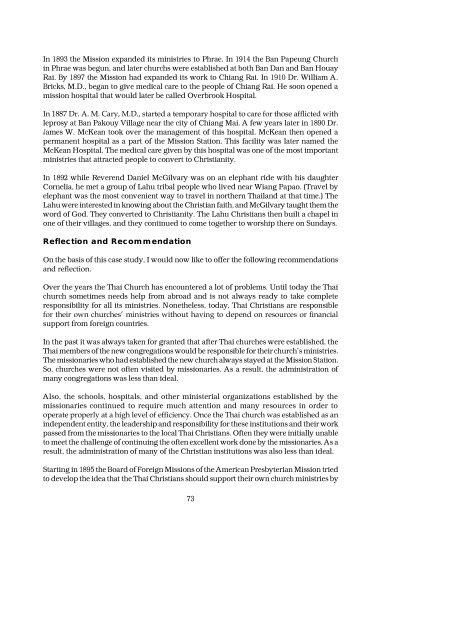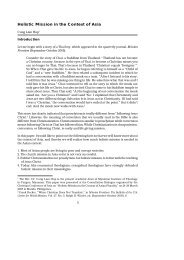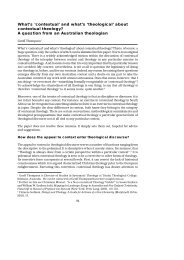Mission Journey of the Church of Christ in Thailand
Mission Journey of the Church of Christ in Thailand
Mission Journey of the Church of Christ in Thailand
You also want an ePaper? Increase the reach of your titles
YUMPU automatically turns print PDFs into web optimized ePapers that Google loves.
In 1893 <strong>the</strong> <strong>Mission</strong> expanded its m<strong>in</strong>istries to Phrae. In 1914 <strong>the</strong> Ban Papeung <strong>Church</strong><br />
<strong>in</strong> Phrae was begun, and later churchs were established at both Ban Dan and Ban Houay<br />
Rai. By 1897 <strong>the</strong> <strong>Mission</strong> had expanded its work to Chiang Rai. In 1910 Dr. William A.<br />
Bricks, M.D., began to give medical care to <strong>the</strong> people <strong>of</strong> Chiang Rai. He soon opened a<br />
mission hospital that would later be called Overbrook Hospital.<br />
In 1887 Dr. A. M. Cary, M.D., started a temporary hospital to care for those af� icted with<br />
leprosy at Ban Pakouy Village near <strong>the</strong> city <strong>of</strong> Chiang Mai. A few years later <strong>in</strong> 1890 Dr.<br />
James W. McKean took over <strong>the</strong> management <strong>of</strong> this hospital. McKean <strong>the</strong>n opened a<br />
permanent hospital as a part <strong>of</strong> <strong>the</strong> <strong>Mission</strong> Station. This facility was later named <strong>the</strong><br />
McKean Hospital. The medical care given by this hospital was one <strong>of</strong> <strong>the</strong> most important<br />
m<strong>in</strong>istries that attracted people to convert to <strong>Christ</strong>ianity.<br />
In 1892 while Reverend Daniel McGilvary was on an elephant ride with his daughter<br />
Cornelia, he met a group <strong>of</strong> Lahu tribal people who lived near Wiang Papao. (Travel by<br />
elephant was <strong>the</strong> most convenient way to travel <strong>in</strong> nor<strong>the</strong>rn <strong>Thailand</strong> at that time.) The<br />
Lahu were <strong>in</strong>terested <strong>in</strong> know<strong>in</strong>g about <strong>the</strong> <strong>Christ</strong>ian faith, and McGilvary taught <strong>the</strong>m <strong>the</strong><br />
word <strong>of</strong> God. They converted to <strong>Christ</strong>ianity. The Lahu <strong>Christ</strong>ians <strong>the</strong>n built a chapel <strong>in</strong><br />
one <strong>of</strong> <strong>the</strong>ir villages, and <strong>the</strong>y cont<strong>in</strong>ued to come toge<strong>the</strong>r to worship <strong>the</strong>re on Sundays.<br />
Reflection and Recommendation<br />
On <strong>the</strong> basis <strong>of</strong> this case study, I would now like to <strong>of</strong>fer <strong>the</strong> follow<strong>in</strong>g recommendations<br />
and re� ection.<br />
Over <strong>the</strong> years <strong>the</strong> Thai <strong>Church</strong> has encountered a lot <strong>of</strong> problems. Until today <strong>the</strong> Thai<br />
church sometimes needs help from abroad and is not always ready to take complete<br />
responsibility for all its m<strong>in</strong>istries. None<strong>the</strong>less, today, Thai <strong>Christ</strong>ians are responsible<br />
for <strong>the</strong>ir own churches’ m<strong>in</strong>istries without hav<strong>in</strong>g to depend on resources or � nancial<br />
support from foreign countries.<br />
In <strong>the</strong> past it was always taken for granted that after Thai churches were established, <strong>the</strong><br />
Thai members <strong>of</strong> <strong>the</strong> new congregations would be responsible for <strong>the</strong>ir church’s m<strong>in</strong>istries.<br />
The missionaries who had established <strong>the</strong> new church always stayed at <strong>the</strong> <strong>Mission</strong> Station.<br />
So, churches were not <strong>of</strong>ten visited by missionaries. As a result, <strong>the</strong> adm<strong>in</strong>istration <strong>of</strong><br />
many congregations was less than ideal.<br />
Also, <strong>the</strong> schools, hospitals, and o<strong>the</strong>r m<strong>in</strong>isterial organizations established by <strong>the</strong><br />
missionaries cont<strong>in</strong>ued to require much attention and many resources <strong>in</strong> order to<br />
operate properly at a high level <strong>of</strong> ef� ciency. Once <strong>the</strong> Thai church was established as an<br />
<strong>in</strong>dependent entity, <strong>the</strong> leadership and responsibility for <strong>the</strong>se <strong>in</strong>stitutions and <strong>the</strong>ir work<br />
passed from <strong>the</strong> missionaries to <strong>the</strong> local Thai <strong>Christ</strong>ians. Often <strong>the</strong>y were <strong>in</strong>itially unable<br />
to meet <strong>the</strong> challenge <strong>of</strong> cont<strong>in</strong>u<strong>in</strong>g <strong>the</strong> <strong>of</strong>ten excellent work done by <strong>the</strong> missionaries. As a<br />
result, <strong>the</strong> adm<strong>in</strong>istration <strong>of</strong> many <strong>of</strong> <strong>the</strong> <strong>Christ</strong>ian <strong>in</strong>stitutions was also less than ideal.<br />
Start<strong>in</strong>g <strong>in</strong> 1895 <strong>the</strong> Board <strong>of</strong> Foreign <strong>Mission</strong>s <strong>of</strong> <strong>the</strong> American Presbyterian <strong>Mission</strong> tried<br />
to develop <strong>the</strong> idea that <strong>the</strong> Thai <strong>Christ</strong>ians should support <strong>the</strong>ir own church m<strong>in</strong>istries by<br />
73




